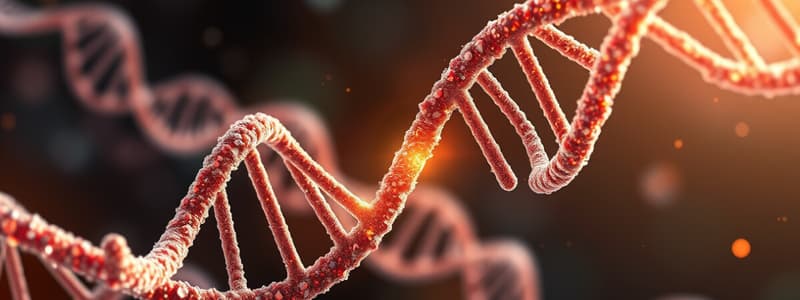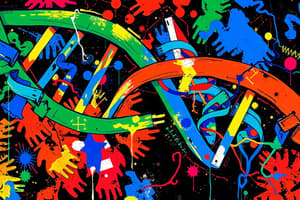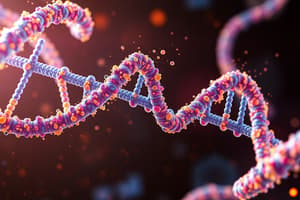Podcast
Questions and Answers
RNA contains the sugar?
RNA contains the sugar?
Ribose
Unlike DNA, RNA contains?
Unlike DNA, RNA contains?
Uracil
Name three things found in both DNA and RNA.
Name three things found in both DNA and RNA.
Phosphate groups, guanine, and cytosine
Which nucleotide indicates the nucleic acid above is RNA?
Which nucleotide indicates the nucleic acid above is RNA?
RNA is usually ------- stranded.
RNA is usually ------- stranded.
Which type of RNA brings the information in the genetic code from the nucleus to other parts of the cell?
Which type of RNA brings the information in the genetic code from the nucleus to other parts of the cell?
Which molecules are involved in protein synthesis?
Which molecules are involved in protein synthesis?
From which molecules are mRNA molecules transcribed?
From which molecules are mRNA molecules transcribed?
What is produced during transcription?
What is produced during transcription?
During eukaryotic transcription, an RNA molecule is formed that is?
During eukaryotic transcription, an RNA molecule is formed that is?
What does the figure show?
What does the figure show?
How many nucleotides are needed to specify three amino acids?
How many nucleotides are needed to specify three amino acids?
There are 64 codons and 20 amino acids. Which of the following is true?
There are 64 codons and 20 amino acids. Which of the following is true?
In Figure 13-3, which amino acid is specified by the mRNA code CCC?
In Figure 13-3, which amino acid is specified by the mRNA code CCC?
According to Figure 13-3, which code specifies the same amino acid as UAU?
According to Figure 13-3, which code specifies the same amino acid as UAU?
A promoter is a?
A promoter is a?
What happens during translation?
What happens during translation?
Which of the following terms is LEAST closely related to the others?
Which of the following terms is LEAST closely related to the others?
During translation, the type of amino acid that is added to the growing polypeptide depends on the?
During translation, the type of amino acid that is added to the growing polypeptide depends on the?
A protein is being assembled when?
A protein is being assembled when?
Genes contain instructions for assembling?
Genes contain instructions for assembling?
Which is the correct sequence of the transfer of information in most organisms?
Which is the correct sequence of the transfer of information in most organisms?
Which of the following best describes what happens during gene expression?
Which of the following best describes what happens during gene expression?
In eukaryotes?
In eukaryotes?
The three types of RNA are -------- RNA, ------- RNA, and ------- RNA.
The three types of RNA are -------- RNA, ------- RNA, and ------- RNA.
DNA molecules ------ the nucleus; RNA molecules ----- the nucleus.
DNA molecules ------ the nucleus; RNA molecules ----- the nucleus.
During DNA replication, ------ strands of DNA serve as a template.
During DNA replication, ------ strands of DNA serve as a template.
A codon consists of --- nucleotides.
A codon consists of --- nucleotides.
The anticodon AGA is complementary to the mRNA codon?
The anticodon AGA is complementary to the mRNA codon?
In Figure 13-6, A, B, and C are three types of?
In Figure 13-6, A, B, and C are three types of?
In RNA, -------- is the sugar in the nucleotide.
In RNA, -------- is the sugar in the nucleotide.
A eukaryotic gene consists of --------, a(an) --------, and the ------- that is transcribed.
A eukaryotic gene consists of --------, a(an) --------, and the ------- that is transcribed.
During transcription, RNA polymerase binds to DNA and assembles nucleotides into a strand that is complementary to the DNA template.
During transcription, RNA polymerase binds to DNA and assembles nucleotides into a strand that is complementary to the DNA template.
The order of nitrogenous bases in DNA determines the order of amino acids in proteins.
The order of nitrogenous bases in DNA determines the order of amino acids in proteins.
The codon that signals the end of a growing polypeptide is called a stop codon.
The codon that signals the end of a growing polypeptide is called a stop codon.
The tRNA bases called the anticodons are complementary to three consecutive nucleotides on an mRNA molecule.
The tRNA bases called the anticodons are complementary to three consecutive nucleotides on an mRNA molecule.
Two cellular processes, transcription and translation, are the main activities described in the central dogma of molecular biology.
Two cellular processes, transcription and translation, are the main activities described in the central dogma of molecular biology.
The codon AUG is a start codon representing the amino acid Methionine.
The codon AUG is a start codon representing the amino acid Methionine.
The codon UGG is a stop codon representing the amino acid Tryptophan.
The codon UGG is a stop codon representing the amino acid Tryptophan.
Flashcards are hidden until you start studying
Study Notes
RNA Structure and Composition
- RNA includes ribose as its sugar component.
- Unlike DNA, RNA has uracil instead of thymine.
- Both DNA and RNA share phosphate groups, guanine, and cytosine.
RNA Nucleotides and Structure
- RNA is typically single-stranded.
- Uracil indicates a nucleic acid is RNA.
- A codon consists of three nucleotides.
Types and Functions of RNA
- mRNA (messenger RNA) carries genetic information from the nucleus to other cellular regions.
- The three types of RNA involved in protein synthesis are mRNA, ribosomal RNA (rRNA), and transfer RNA (tRNA).
- mRNA is transcribed from DNA, producing RNA molecules.
Transcription and Translation Process
- During transcription, an RNA molecule forms that is complementary to a segment of DNA.
- Transcription occurs in the nucleus, while translation occurs in the cytoplasm.
- In translation, the messenger RNA code directs protein synthesis.
Genetic Code and Amino Acids
- There are 64 codons encoding for 20 amino acids, allowing for redundancy; multiple codons may specify the same amino acid.
- For example, the mRNA codon CCC specifies the amino acid proline (Pro).
Gene Expression and Information Flow
- The standard flow of genetic information is DNA → RNA → Protein.
- Gene expression involves reading DNA instructions to build proteins.
- A protein is assembled when RNA is translated.
Codons and Anticodons
- Anticodons on tRNA are complementary to mRNA codons; for instance, the anticodon AGA pairs with the mRNA codon UCU.
- Start and stop codons regulate the translation process: AUG indicates the start (Methionine), while stop codons terminate the polypeptide chain.
RNA Characteristics in Eukaryotic Cells
- Eukaryotic genes consist of regulatory regions, a promoter, and the transcribed nucleotide sequence.
- RNA molecules can leave the nucleus, while DNA remains contained within it.
Key Facts about Transcription and Translation
- RNA polymerase binds to DNA during transcription, creating a complementary RNA strand.
- The order of nitrogen bases in DNA dictates the sequence of amino acids in proteins.
True/False Statements
- RNA polymerase assembles nucleotides during transcription: True.
- The sequence of bases in DNA determines amino acid order: True.
- A stop codon signifies the end of polypeptide synthesis: True.
- Anticodons on tRNA are complementary to mRNA nucleotides: True.
- Transcription and translation are the two main processes of the central dogma: True.
- AUG is a start codon for Methionine: True.
- UGG is a stop codon that represents Tryptophan: False.
Studying That Suits You
Use AI to generate personalized quizzes and flashcards to suit your learning preferences.





